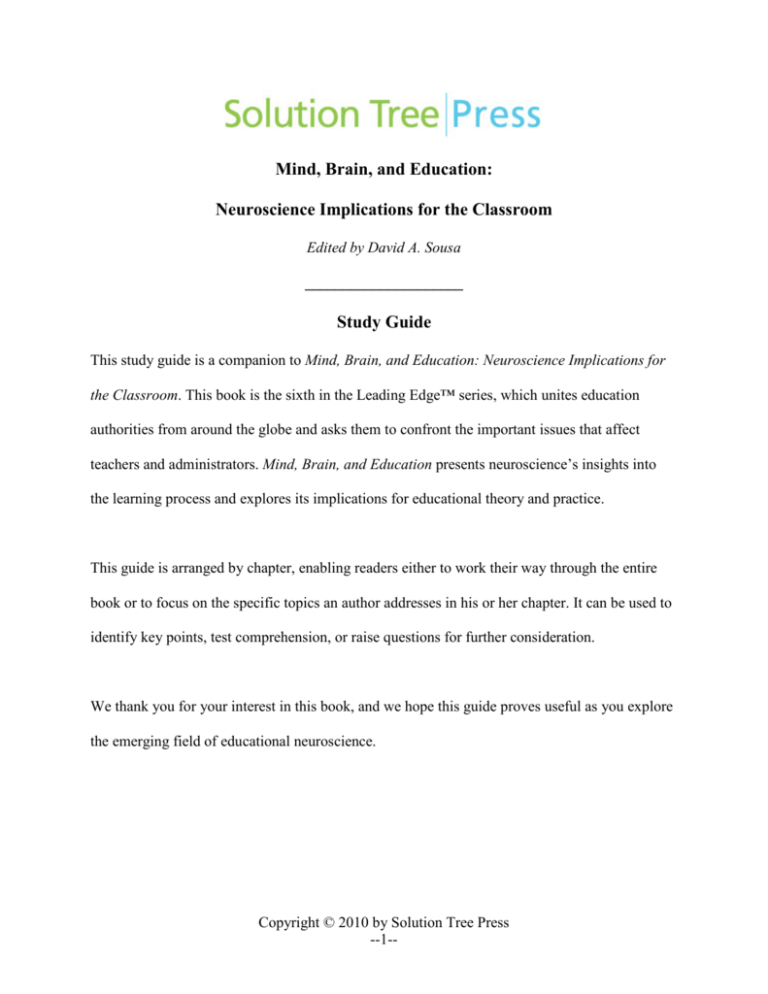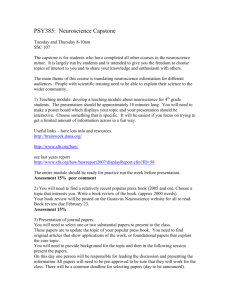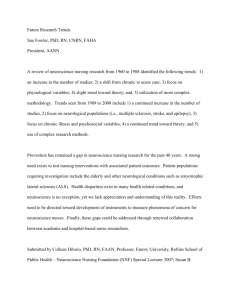Chapter 1 - Solution Tree
advertisement

Mind, Brain, and Education: Neuroscience Implications for the Classroom Edited by David A. Sousa _____________________ Study Guide This study guide is a companion to Mind, Brain, and Education: Neuroscience Implications for the Classroom. This book is the sixth in the Leading Edge™ series, which unites education authorities from around the globe and asks them to confront the important issues that affect teachers and administrators. Mind, Brain, and Education presents neuroscience’s insights into the learning process and explores its implications for educational theory and practice. This guide is arranged by chapter, enabling readers either to work their way through the entire book or to focus on the specific topics an author addresses in his or her chapter. It can be used to identify key points, test comprehension, or raise questions for further consideration. We thank you for your interest in this book, and we hope this guide proves useful as you explore the emerging field of educational neuroscience. Copyright © 2010 by Solution Tree Press --1-- Mind, Brain, and Education: Neuroscience Implications for the Classroom Study Guide —Chapter 1— How Science Met Pedagogy By David A. Sousa _____________________ 1. What technological innovation of the early 1970s revealed the structure of the living brain? What innovation later in that same decade allowed neurologists to study brain function and activity? 2. The author quotes educator Madeline Hunter, who said that “teaching is no longer a ‘laying on of hands.’” What does it mean for education to be a “laying on of hands,” and why is it no longer so? 3. According to the author, brain research conducted in the 1990s was particularly significant for teaching and learning. Briefly summarize the results of that research. 4. Early critics of educational neuroscience accused educators of misunderstanding or misusing neuroscience’s findings. How does the author address these claims, and how does he say the fields of education and neuroscience were reconciled? Copyright © 2010 by Solution Tree Press --2-- Mind, Brain, and Education: Neuroscience Implications for the Classroom Study Guide —Chapter 2— Neuroimaging Tools and the Evolution of Educational Neuroscience By Michael I. Posner _____________________ 1. What are the differences between structural and functional imaging of the human brain? 2. What are the relative strengths of using hemodynamic imaging, such as PET or fMRI, versus using electrical or magnetic recording from the scalp? 3. In a person with dyslexia, what areas of the brain are likely to be poorly activated when reading words? 4. What difficulties might a person find in reading if a lesion destroyed the visual wordform area? 5. What role does the parietal lobe seem to play in dealing with understanding the quantity of a digit? Copyright © 2010 by Solution Tree Press --3-- Mind, Brain, and Education: Neuroscience Implications for the Classroom Study Guide —Chapter 3— The Current Impact of Neuroscience on Teaching and Learning By Judy Willis _____________________ 1. The author draws a parallel between video games and Lev Vygotsky’s zone of proximal development (ZPD) theory. What do the two have in common, and what are the implications for classroom instruction and assessment? 2. What is the function of the reticular activating system (RAS)? How does the RAS affect learning, and what is its relevance to the classroom environment? 3. The author suggests that the RAS can be “primed” by exposure to novelty. What are some of the priming strategies she proposes for the classroom? What are some other methods a teacher could use to introduce nonthreatening novelty? 4. What part of the brain does the author identify as a primary site of cognition and creativity? How does emotion affect this part of the brain? 5. What is dopamine? What does it do, and how does it affect learning? 6. What is neuroplasticity? How is this phenomenon significant in the context of the classroom environment and student–teacher interaction? Copyright © 2010 by Solution Tree Press --4-- Mind, Brain, and Education: Neuroscience Implications for the Classroom Study Guide 7. How is patterning defined in this chapter? How is patterning connected to memory, and in what ways can its growth be promoted? Copyright © 2010 by Solution Tree Press --5-- Mind, Brain, and Education: Neuroscience Implications for the Classroom Study Guide —Chapter 4— The Role of Emotion and Skilled Intuition in Learning By Mary Helen Immordino-Yang and Matthias Faeth _____________________ 1. According to the authors, how are emotions typically viewed in the school environment? What evidence do they find in the Iowa Gambling Task that suggests the opposite view? 2. How do “irrelevant” emotions such as anxiety impact learning? What effect does a lack of emotional connection and relevance have on learning? 3. Describe the first strategy the authors suggest for incorporating emotion into classroom learning. Which of their examples of this strategy is most appealing to you? Why? 4. Aside from its effectiveness in delivering content, in what ways might students benefit from increased emotional connection and investment in the classroom? 5. Describe the second strategy for incorporating emotion into classroom learning. What challenges and opportunities does this strategy present? 6. Describe the third strategy for incorporating emotion into classroom learning. Why do the authors describe this as “a balancing act”? How is the appropriate balance achieved? Copyright © 2010 by Solution Tree Press --6-- Mind, Brain, and Education: Neuroscience Implications for the Classroom Study Guide —Chapter 5— The Speaking Brain By Diane L. Williams _____________________ 1. Name the two ways in which the right hemisphere of the brain may contribute to the use of language. 2. What is the cognitive skill referred to as “theory of mind”? How is this skill thought to contribute to the comprehension of language? 3. What areas and characteristics of the brain allow the rapid exchange of speech in conversation? Briefly describe what occurs in these areas during conversation. 4. What understanding of the process and timing of language development dominated before the advances made possible by neuroscience? How has more recent research modified this earlier model of language development? 5. What is the current state of knowledge about gender-based differences in language processing? 6. According to the author, there has been a general concern that exposing young children to two languages hinders the development of both. Has this fear been borne out by research? Copyright © 2010 by Solution Tree Press --7-- Mind, Brain, and Education: Neuroscience Implications for the Classroom Study Guide How does the brain that has acquired two languages early in life differ from one that learned a second language later in life? Copyright © 2010 by Solution Tree Press --8-- Mind, Brain, and Education: Neuroscience Implications for the Classroom Study Guide —Chapter 6— The Reading Brain By John Gabrieli, Joanna A. Christodoulou, Tricia O’Loughlin, and Marianna D. Eddy _____________________ 1. What two competing goals do the authors say the brain must balance when engaging with text? What are the two mental and neural methods used by the brain to achieve these goals? 2. What is the visual word form area, discussed throughout the chapter? How does it enable reading? 3. What is phonological awareness? How is this ability connected to reading? 4. What three changes generally occur in the brain as children (early readers) develop into adults (mature readers)? 5. What are some of the neurological signs of dyslexia? 6. How do reading interventions affect the structure and function of the reading brain? Copyright © 2010 by Solution Tree Press --9-- Mind, Brain, and Education: Neuroscience Implications for the Classroom Study Guide —Chapter 7— Constructing a Reading Brain B y Donna Coch _____________________ 1. What three constituent systems of the reading brain does the author consider in this chapter? 2. What two pathways does the brain use in the cortical visual processing of written language? What is the function of each? 3. What is a phoneme? What is a grapheme? 4. What is grapheme-to-phoneme correspondence? What does it mean for a language to have deep orthography? 5. The author reports on a reading task in which activity in one part of the brain was correlated with activity in another. What general conclusion about the neurology of reading can be drawn from the results of this study, and what does this suggest about the neurology of reading difficulties? 6. How is early spoken vocabulary acquisition relevant to the development of reading skills? What consequences does this imply for a child who begins to learn to read without a robust spoken vocabulary? Copyright © 2010 by Solution Tree Press --10-- Mind, Brain, and Education: Neuroscience Implications for the Classroom Study Guide 7. What are some of the abilities that provide critical support to reading comprehension (the ability to make meaningful connections with a text)? How does the author suggest these abilities can be fostered in the classroom? Copyright © 2010 by Solution Tree Press --11-- Mind, Brain, and Education: Neuroscience Implications for the Classroom Study Guide —Chapter 8— The Mathematical Brain By Keith Devlin _____________________ 1. What does the author suggest are the two main obstacles facing mathematics teachers? Why does he say that “mathematics teaching remains largely an art”? 2. What are the “bottom-up” and “top-down” components of learning arithmetic? What are some of the linguistic challenges a student might face in the top-down component of arithmetic education? 3. The author notes an ongoing debate between those who think education should emphasize rote learning and those who favor not using it at all. Where do you fall between these two extremes? What scientific and experiential justifications does the author offer for his view that rote learning has a place in mathematics education? 4. How does the author explain the difficulties many adults have with multiplication facts? What are some ways these difficulties might be avoided or overcome in mathematics education? 5. What are differences between algebra and arithmetic with respect to cognition? What additional difficulty does algebra present to the human mind? Copyright © 2010 by Solution Tree Press --12-- Mind, Brain, and Education: Neuroscience Implications for the Classroom Study Guide 6. What pedagogical strategy appears most effective in teaching mathematics? Copyright © 2010 by Solution Tree Press --13-- Mind, Brain, and Education: Neuroscience Implications for the Classroom Study Guide —Chapter 9— The Calculating Brain By Stanislas Dehaene _____________________ 1. What did Jean Piaget assert about the existence of number sense in young children? How does the author critique Piaget’s conclusions? 2. What has the concept of “approximate number” revealed about number sense in young children and its development over time? How was this number sense measured even in infants with no verbal language ability? 3. What is the “triple-code organization” by which the brain calculates? What three aspects of calculation are handled by this organizational system, and how do these aspects differ from one another? 4. What are two of the “recipes” by which the brain calculates? 5. What do these varied recipes suggest about how the brain approaches the task of calculation, and what does this imply for the development of mathematical skill in children? Copyright © 2010 by Solution Tree Press --14-- Mind, Brain, and Education: Neuroscience Implications for the Classroom Study Guide 6. Unlike the approximate number system, the author says, understanding of exact number does not appear to be innate in humans. What innate faculty does the author suggest forms the foundation of the ability to understand exact number? 7. How are numbers connected to a sense of physical space in the human brain? What does this connection reveal about how the brain adapts to meet new conceptual demands? 8. How, according to the author, can children’s innate number sense be strengthened? What are some specific activities that could be incorporated into existing mathematics education to accomplish this? Copyright © 2010 by Solution Tree Press --15-- Mind, Brain, and Education: Neuroscience Implications for the Classroom Study Guide —Chapter 10— The Computing Brain By Daniel Ansari _____________________ 1. What is developmental dyscalculia (DD)? What are some of its indications or effects? Approximately how common is DD? 2. What is the numeric distance effect? What does it suggest about the different ways the brain enumerates and calculates? 3. The author cites a 2005 study in which participants of various ages were presented with arithmetic and number-recognition tasks. What did this study reveal about how the brain’s handling of these tasks changes with age? 4. What three principal insights does the author draw from his review of the literature on the neurology of computation? 5. What do fMRI studies of individuals with DD, or with more general developmental disorders, reveal about the neurology of calculation difficulties? 6. The author discusses variations in problem-solving strategy and in mathematical competence among individuals with otherwise comparable intelligence. What has the Copyright © 2010 by Solution Tree Press --16-- Mind, Brain, and Education: Neuroscience Implications for the Classroom Study Guide study of these variations revealed about their neurological origins? What are some of the educational implications of these differences? 7. Why do you think the author is reluctant to give specific prescriptions for educational practice? Why does he advocate allowing insights from a variety of disciplines to inform educational practice? Copyright © 2010 by Solution Tree Press --17-- Mind, Brain, and Education: Neuroscience Implications for the Classroom Study Guide —Chapter 11— The Creative-Artistic Brain By Mariale M. Hardiman _____________________ 1. What does the author mean by divergent thinking, and how does it differ from convergent thinking? What are some activities with which a teacher might engage students to promote divergent thinking? 2. How is the brain activity involved in creative thinking different from the brain activity involved in conventional thinking? 3. How might integration of the arts into classroom instruction in other subjects improve student learning? What are some ways that you might integrate the arts into your classroom instruction? 4. What is the Brain-Targeted Teaching Model, and how can it improve teaching practices? Which brain targets do you regularly incorporate into your instructional program? Which would you like to further develop with a view to strengthening your instructional delivery and improving student learning? 5. What educational policies are needed in order to promote arts integration and creativity in the classroom, as suggested by the Brain-Targeted Teaching Model? How might the policies of your school or school district need to be adjusted to accommodate these goals? Copyright © 2010 by Solution Tree Press --18-- Mind, Brain, and Education: Neuroscience Implications for the Classroom Study Guide —Chapter 12— The Future of Educational Neuroscience By Kurt W. Fischer and Katie Heikkinen _____________________ 1. How do the authors characterize the relationship between medical research and practice? How do they contrast this with educational research and practice? 2. Describe the model of the human mind that predominates in Western societies. How do the authors critique this way of understanding the human mind? 3. What is the conduit metaphor of learning? Contrast this with the construction site metaphor. 4. Summarize the skill web suggested by the authors as a more appropriate way of thinking about skill development. How is this model better aligned with the current state of educational neuroscience? 5. What are the two characteristics of dynamic systems discussed by the authors? 6. What four changes do the authors recommend for promoting interdisciplinary collaboration in education? Copyright © 2010 by Solution Tree Press --19--




